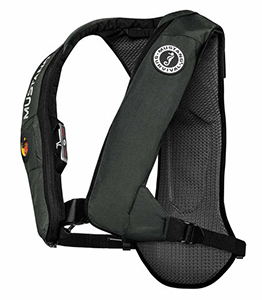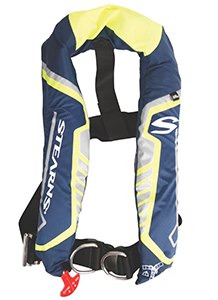When you absolutely need it, there are few things as valuable as a personal floatation device. In the unlikely event you end up overboard, the extra flotation will keep your head above water far longer than you could on your own. An inflatable PFD should give you the best of both worlds: It’s largely out of the way when you don’t need it, but inflates and gives you lifesaving lift when you’re in the water. But too many boaters aren’t maintaining inflatable PFDs properly, making them less likely to work during emergencies.
It’s impossible to know how many of the nearly 12 million recreational boats registered in the U.S. have faulty PFDs on board. But anecdotal evidence suggests there are plenty out there. And manufacturers of inflatable PFDs, like Stearns and Mustang, stress the need for paying attention to inflatable units both in maintenance and proper handling.
Mustang Survival, for example, offers voluntary inspections during fishing tournaments and other events. During one recent event, company staff found a good number of inflatable PFDs that were not properly maintained.
“We looked at 50 anglers and found about 5 to 10 percent of our products would not have worked if people needed them to,” said Shannon Ward, who handles marketing for the company based in Burnaby, British Columbia.
Meanwhile, the U.S. Coast Guard recently released a safety alert identifying defective Type I life jackets. The failure stems from straps that are fused to the side of the unit, making it impossible to place over one’s head.
“Based on the number of problematic PFDs discovered, the Coast Guard is strongly recommending that owners and operators using this type of PFD inspect each one for this condition,” the agency said in the alert.
The Coast Guard specifically has not named the company involved until it has gathered more information about the scope of the problem.
Inflatable PFDs contain a CO2 cartridge that inflates the chamber during emergencies to provide buoyancy. There are models on the market that activate manually, automatically or when submerged in water. But like any equipment, its components require occasional upkeep.
 |
|
Mustang Survival’s MD5183 inflatable unit. |
|
Courtesy Mustang Survival |
Corrosion a potential problem
Like other technical equipment on a sailboat, this equipment needs regular inspections to make sure everything is in working order. Common issues can include corrosion on the CO2 cylinder or a CO2 cylinder that has been activated prior to use.
Ward said it’s not uncommon for children to activate the PFD cartridge — either on purpose or by accident — then let the air out and repack the PFD without telling their parents. In this case, users would not know the cartridge is empty unless they inspected it before putting it on.
Manufacturers typically include precise maintenance schedules with their products. In addition, Mustang recently released a safety primer with recommended steps for each time the inflatable PFD is worn, every two months, and each year at the start of boating season.
Prior to each use, the PFD should be visually checked for tears, holes and other abrasions. It should not be twisted, the manual inflator pull tab should be outside the PFD, and the inflator status indicator should be green, Mustang said in its guidance.
Every two months during boating season, the company recommends fully inflating the PFD orally, then holding the valve under water to check for bubbles. If they appear, the PFD should be deflated and inflated again. After orally inflating the PFD, it should remain inflated for 16 hours to check for leaks. PFDs with bobbin activation systems also should be checked to make sure the yellow “pill” remains intact. If it appears faulty, the pill should be replaced.
“The benefit is that this lets them actually see how the PFDs work,” Ward said of preventative maintenance. “A lot of people don’t know how they work when they inflate, or they don’t know where the air comes from or how it fills the chamber.”
Mustang recommends boaters give their PFDs a thorough inspection annually and also conduct the leak and oral valve inflation tests. The jacket should be cleaned, and corroded parts should be replaced.
 |
|
A Stearns C-Tek 38 automatic/manual inflatable PFD. |
|
Courtesy Stearns |
These steps, she added, can serve as a reminder that inflatable PFDs are technical pieces of equipment, and can help owners become familiar with their devices. Repairing or replacing components on inflatable PFDs, she said, does not require special knowledge.
The Stearns company issues care recommendations with every PFD sold. Stearns suggests: 1) letting PFDs drip-dry before stowing, 2) not placing them on heat sources to speed drying time and 3) checking PFDs often for rips, tears or holes.
“There should be no signs of the PFD being waterlogged, no mildew odor should be present, or visible shrinkage of the buoyant materials,” according to Stearns.
The company also calls for checking PFDs each year at the start of boating season to make sure the jacket is serviceable. Other gear should not be stowed on top of PFDs.
Jackie Yurkovich, staff engineer with the U.S. Coast Guard Lifesaving and Fire Safety Division, echoed many of the manufacturers’ tips around PFD maintenance and upkeep. She also noted that regular use of life jackets can be a key part of the equation.
“Wearing a life jacket and taking care of a life jacket go hand in hand,” Yurkovich said in a recent interview. “If people are wearing it, they will want to know if it’s moldy, or ripped or if something doesn’t fit right.”
Casey Conley is the editor of American Tugboat Review.

